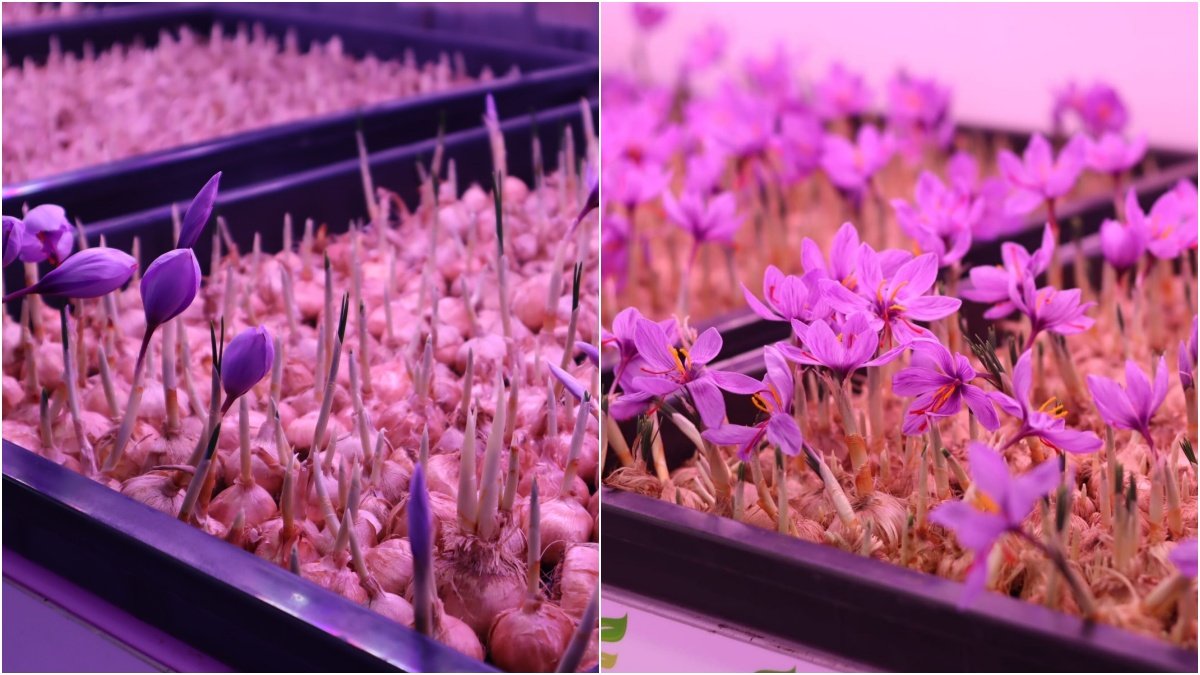In a groundbreaking agricultural feat, 38-year-old former techie Hemant Srivastava has successfully cultivated saffron, India’s most expensive spice, in a 300-square-foot lab in Lucknow, Uttar Pradesh.
Employing aeroponics, an advanced soil-free farming technique, Srivastava recreated Kashmir’s unique climate and light conditions, overcoming geographical and environmental barriers. This innovative venture not only sets a benchmark in agricultural technology but also challenges the traditional notion that saffron can only thrive in the cool climes of Kashmir.
A Bold Leap from Silicon Valley to Lucknow
Srivastava, who once enjoyed a high-profile career in Silicon Valley, made the unconventional decision to leave the tech industry and pursue his agrarian dream in his hometown of Vijayant Khand, Gomti Nagar. Inspired by online videos and driven by a passion for innovation, Srivastava embarked on a journey to replicate Kashmir’s saffron cultivation techniques in an urban setup.
“When I realized there wasn’t much suitable land in Lucknow, I decided to try growing saffron at home,” Srivastava shared. Determined to master the nuances of saffron farming, he traveled to Kashmir, met with local farmers, and studied their methods before adapting them to a controlled environment.

Innovative Techniques: Aeroponics and Vertical Farming
The success of Srivastava’s saffron farm lies in the integration of aeroponics and vertical farming techniques. Aeroponics is a high-tech farming process where plants are grown without soil or water. Instead, the plants are suspended in the air, and nutrients are delivered directly to their roots in a controlled setup.
“Initially, the saffron bulbs are planted in soil to absorb nutrients. They then go dormant before being moved to the controlled environment, where we keep them in darkness for two months. Afterward, we expose them to artificial light that mimics the complete spectrum of sunlight necessary for photosynthesis,” explained Srivastava.
He also employed vertical farming, a method that maximizes yield by growing plants in stacked layers, making efficient use of limited space. “By combining these methods, we can grow more plants in less space,” he added.
Replicating Kashmir’s Climate in Lucknow
Srivastava’s indoor farm is an air-conditioned hall designed to simulate the cool climate of Kashmir. The saffron bulbs, which are highly sensitive to temperature and light conditions, thrive in this meticulously controlled environment. “I was told that saffron plants are extremely delicate and that even slight mismatches in conditions could spoil the crop. But I’m thrilled that our efforts have yielded positive results,” Srivastava remarked.
The controlled setup replicates Kashmir’s growing conditions, ensuring that the saffron blooms retain the same quality as their native counterparts. This achievement is particularly significant given the challenges of cultivating saffron outside its traditional habitat.

Costs and Challenges of Indoor Saffron Farming
Cultivating saffron in a controlled indoor setup comes with its own set of challenges, primarily financial. Srivastava revealed that setting up such a farm costs between ₹7 lakh and ₹10 lakh, making it a relatively expensive venture for small-scale farmers. However, the high value of saffron, often referred to as “red gold,” offsets these costs.
Kashmiri saffron is prized for its rich aroma, vibrant color, and medicinal properties, fetching prices of ₹2-3 lakh per kilogram in the market. By making saffron cultivation feasible in non-traditional regions, Srivastava’s innovation holds the potential to revolutionize the spice industry in India.
A Family Collaboration and the Dream Realized
Srivastava’s journey was a collaborative effort with his father, a retired judge, who shared his vision for this ambitious project. Together, they defied the odds to achieve the first saffron bloom in Lucknow. “This was a dream I never thought would come true. But with perseverance and technology, we managed to bridge the geographical gap,” Srivastava said.
His success has attracted interest from agricultural enthusiasts and researchers alike, who see this as a template for replicating similar projects in urban and semi-urban settings.
The Future of Saffron Cultivation in India
Srivastava’s innovation not only highlights the potential of aeroponics but also opens up possibilities for growing high-value crops in areas previously deemed unsuitable. By adopting modern farming methods, India can reduce its dependency on imports and boost domestic production of premium spices like saffron.
Moreover, the success of such ventures encourages the younger generation to explore agriculture as a viable and rewarding career path. Srivastava’s journey from Silicon Valley to saffron farming serves as an inspiring story of how technology and determination can overcome even the most formidable challenges.
A New Chapter in Agricultural Innovation
Hemant Srivastava’s saffron farm in Lucknow represents a transformative moment in India’s agricultural landscape. By leveraging aeroponics and vertical farming, he has demonstrated that the impossible can be achieved with innovation and persistence. As more farmers and entrepreneurs take cues from Srivastava’s success, the dream of growing Kashmir’s famed saffron across the country might soon become a reality.

